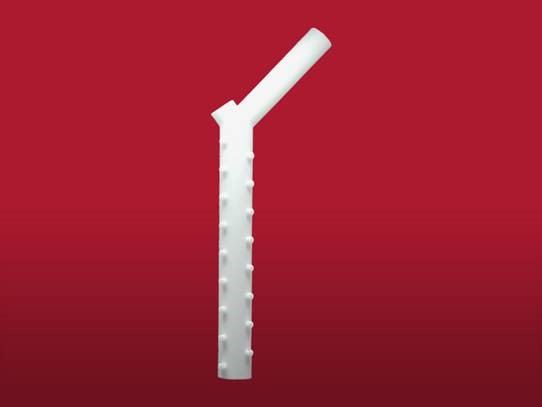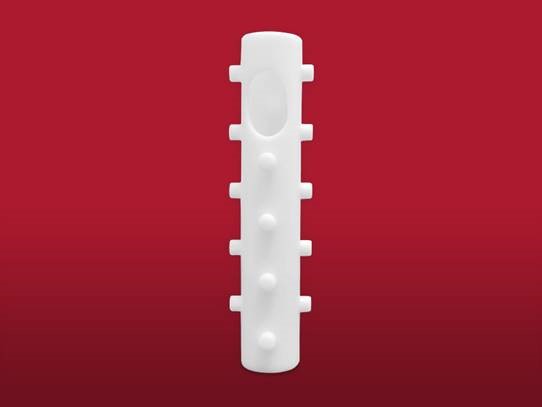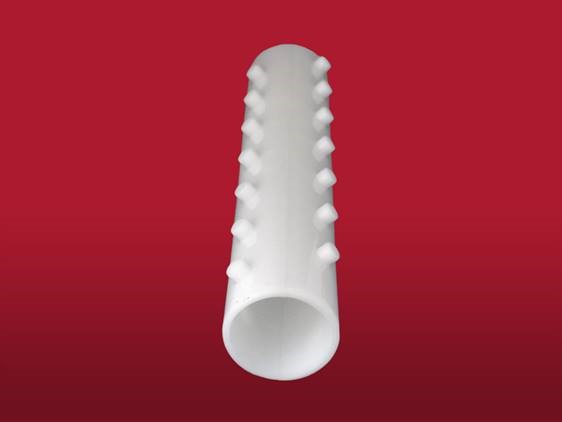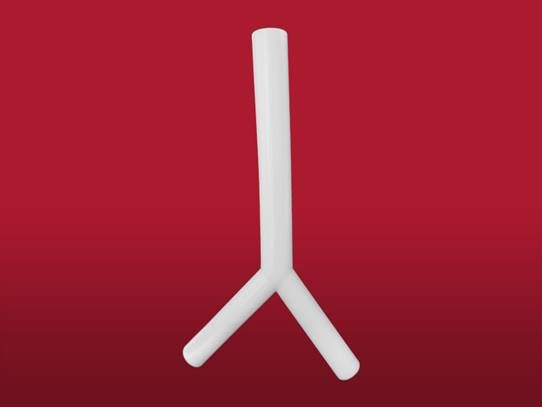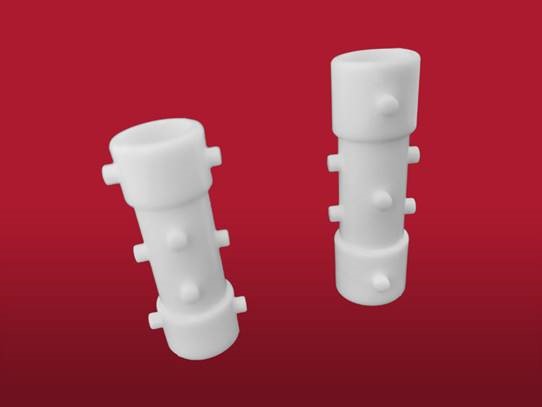Trakeal Silikon Stent
Tracheobronchial Stent
The Stening® Tracheobronchial stent is the classical and straight stent for tracheal and bronchial affections. It has a tubular structure, with flat surface anchoring studs on it outer wall to prevent stent migration.
Indications
Primary or secondary bronchial/tracheal neoplasms
Tracheoesophageal fistula
Bronchial/tracheal rupture
After laser resection, cryotherapy or electrocautery, to maintain the airway opened
Extrinsic compression or commitment of the submucosa
Post-intubation stenosis
Post-traumatic stenosis
Post infectious stenosis (endobronchial tuberculosis, histoplasmosis mediastinal fibrosis, herpes virus, diphtheria)
Post inflammatory stenosis: Wegener’s disease
Focal trachea-broncho-malacia: following tracheostomy or radiation therapy
Diffuse trachea-broncho-malacia: idiopathic, polychondritis or Mounier-Kuhn syndrome
Tracheal/bronchial tumors
Amyloidosis
Excessive dynamic compression of the airway
Postsurgical term-terminal bronchial anastomosis stenosis
Broncho-malacia
Bronchus invasion caused by an esophageal carcinoma
After endoscopic resection of bronchial metastasismetastasis
Conical Bronchial Stent
The Stening® Class Stent is a device designed to maintain the clearance of the airway in sufficient conditions for ventilation. It has a conical elastic tubular structure, with nonslip spurs arranged in several rows and distributed symmetrically along its surface.
Indications:
Bronchial neoplasms
Neoplasms that invade tracheal carina or its slopes Following laser photoresection, cryotherapy or electrocautery, to maintain the opening of the airway
Invasion of bronchial sources by esophageal carcinoma
Postinfectious stenosis (tuberculosis, histoplasmosis with mediastinal fibrosis, herpes virus, diphtheria)
Impending atelectasis
Bronchial stenosis
Post-traumatic stenosis
Post-terminal surgical
bronchial anastomosis stenosis
Bronchial rupture
Extrinsic compression
Bronchomalacia
Bronchial Amyloidosis
Excessive dynamic compression of the airway
After endoscopic resection of bronchial metastases
Conical Bronchial Stent
The Stening® ROLL is a special stent for common trunk of the basal segment of the lower lobes (left and right). Due to this, the stent possesses more smaller studs that provide a smooth support and with more distribution points of its loads. So that, its short dimensions make possible its fitting inside the bronchus’conical shape, avoiding the distortion produced by the classical stents with a cylindrical shape. For individual anatomic variations we have three versions: ROLL810, ROLL911 (both with a length of 20 mm)
The Stening® ROLL can be cut on their margins to fit the length of the bronchus where they are implanted. Effectuate the section on its proximal margin, because this one does not confront any bronchial spur during the respiratory dynamic..
A stent implant inside the common trunk of the lower lobar can end in an occlusion on the entrance of the apical segment. The doctor must evaluate the benefits of restoring the ventilation of the basal ones in spite of the loss of the apical from the lower one. This must be done when this last one would not be affected by the neoplastic disease..
Indications:
A complete or partial obstruction of the lower lobar bronchus with unscathed basal ones
A complete or partial obstruction of the common trunk of the basal ones in the
lower lobe (right or left)
A complete or partial obstruction of the intermediate bronchus
A combination of the ones above
Tracheal Stenosis Stent
It is a tracheal stent of easy implant and removal. It is especially suitable for the benign stenosis treatment. With a 14, 15 and 16 mm diameter on its extremes and a 12, 13 and 14 mm diameter respectively on its central portion, constitutes a profile that increase the difficulty of its spontaneous displacement after being introduced. The stents for tracheal stenosis (SET) have a 5 mm longer version: “L”. These variants are how Stening® responds to the needs on treatment for special clinical situations
Indications:
Simple tracheal stenosis
Complex and long tracheal stenosis
Stenosis combined with malacia or compression
After laser resection, cryotherapy or electrocautery, to maintain the
airway opened
Post infectious stenosis (endobronchial tuberculosis,
histoplasmosis mediastinal fibrosis, herpes virus, diphtheria)
Post anastomosis surgical tracheal stenosis
Architecture modifications, deformity, bending (senile trachea)
Extrinsic compression
Tracheocarinobronchial Stent (occlusive)
Flexible tracheocarinobronchial prosthesis for supporting tracheal bifurcation and carinal angle, able to maintain ventilation through the main bronchi in very advanced obstructive conditions. It has one of its bronchial branches completely occluded on its origin. Thereby, the stent satisfies a special function, allowing the ventilation from the healthy lung on patients with a postsurgical broncopleural fistula or from other etiologies and that require mechanical respiratory assistance. The occluded branch impedes the air flow loss through the vast communication with the pleural cavity.
Indications:
A right or left bronchopleural fistula, from any etiology, with or without the MRA (Mechanical Respiratory Assistance) need
A bronchopleural fistula accompanied by empyema on patients with a tube drainage or buleau
Subglottic Stent
That could help to reduce the turbulence of the air flow and the secretions impaction. The subglottic stent presents an 8 mm section on its proximal edge where the wall’s thickness is reduced. Throughout this section, its normal wall, of 1.5 mm, reduces its thickness
gradually until it ends.This wall’s thickness decreasing achieves, on that edge, a surface of low resistance on the stent. It is meant to occupy the subglottic region, close to the vocal cords.
This design allows the stent
deformation during the laryngeal movements and the glottal dynamic during swallowing and phonation. The stent fixation on the trachea will be carried out by the remaining walls of the prosthesis, of a standard shape and width. The use of the subglottal stent can be preferred for other locations such as the middle or lower trachea or even in the source bronchi, replacing a classical stent. As it can be understood, when this stent is implanted in the source bronchus, with its “subglottic” edge in the proximal direction, the transition from the bronchial mucosa to the stent
inside will be very smooth, without the “step” that accompanies the classical stent.
Indications:
Tracheal stenosis close to the
subglottis
All indications from every tracheal
and bronchial stent
Thin Wall Stent
It consists on a straight tracheobronchial stent with a thinner wall. This docility makes
its implant and removal easier. It has a special utility after the neoplastic and
endotracheal tissue’s resection, when the affection lacks of a compressive component
Indications:
Primary or secondary tracheal neoplasm
Tracheoesophageal fistula
Tracheal rupture
After laser resection, cryotherapy or electrocautery, to maintain the airway opened
Tracheomalacia
High Pressure Stent
With a more robust wall, this model is very resistant to max compression.
When any stent is put under a strength
test that compresses it with loads that
increase progressively, a stent’s
gradually deformation takes place until it
reaches the cession point. Here, the
prosthesis suffers a higher deformation,
with a notorious reduction of its radial
resistance to flattening. This break point
is about 900 g/cm2 in a classical stent.
In the Stening® High Pressure Stent the tolerance to compression increases surpassing the 2000 g/cm2.
Its wall’s thickness increase is accompanied by an inevitable reduction in the area
available for air flow.
Indications:
Tracheal neoplasms with a solid
extrinsic compression
A severe tracheal compression that
occurs again after the dilatation
In replacement of a classical stent
that collapse by extrinsic compression








